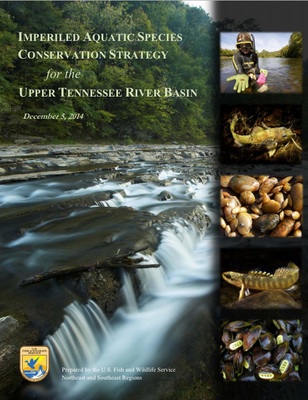The Strategy
 The Strategy identifies a management approach expected to achieve significant conservation benefits in an efficient manner and identifies priority species and locations for management focus. While the Strategy describes an effective and efficient approach towards recovery of imperiled aquatic species in the UTRB, it is not a rigid management prescription but is intended to guide management of these resources. The adaptability of the Strategy will help the U.S. Fish and Wildlife Service (USFWS) better integrate its efforts internally and with those of partners whose missions complement the goal of maximizing conservation and recovery of imperiled aquatic species and the UTRB ecosystem upon which they depend. It is important to note that we do not seek to direct the work of our partners with this Strategy; rather, we seek to prioritize USFWS efforts so that we can make the most effective use of a limited budget and continue to complement the work of our conservation partners. An added benefit of many of the conservation and management actions outlined in the Strategy will be realized for the remainder of species—rare and common alike—that comprise aquatic communities in the UTRB.
The Strategy identifies a management approach expected to achieve significant conservation benefits in an efficient manner and identifies priority species and locations for management focus. While the Strategy describes an effective and efficient approach towards recovery of imperiled aquatic species in the UTRB, it is not a rigid management prescription but is intended to guide management of these resources. The adaptability of the Strategy will help the U.S. Fish and Wildlife Service (USFWS) better integrate its efforts internally and with those of partners whose missions complement the goal of maximizing conservation and recovery of imperiled aquatic species and the UTRB ecosystem upon which they depend. It is important to note that we do not seek to direct the work of our partners with this Strategy; rather, we seek to prioritize USFWS efforts so that we can make the most effective use of a limited budget and continue to complement the work of our conservation partners. An added benefit of many of the conservation and management actions outlined in the Strategy will be realized for the remainder of species—rare and common alike—that comprise aquatic communities in the UTRB.
Download the Full Strategy
Chapters
Purpose - The purpose of the Imperiled Aquatic Species Conservation Strategy for the Upper Tennessee
River Basin (UTRB) (Strategy) is to guide the U.S. Fish and Wildlife Service (USFWS) in the
management of Federal candidate, proposed, and listed (herein collectively referred to as
imperiled) aquatic species in the UTRB.
Introduction and Geographic Scope - The geographic scope of this Strategy is the UTRB, which drains portions of the Blue Ridge, Ridge and Valley, and Appalachian Plateau physiographic provinces of the southern Appalachian Mountains.
Species and Threat Information - There are 13 imperiled fish species extant in the UTRB, which represent 8% of the total fish fauna in the basin and there are 24 imperiled mussel species extant in the UTRB, which represents 29% of the total historic mussel fauna in the basin.
Assumptions and Terminology - During development of the Strategy, these following assumptions and terminology were used.
Strategy Development - Through a series of meetings, workshops, conference calls, webinars, and emails that took place from August 2011 through March 2014, SDM was used to develop and evaluate conservation
strategies intended to increase persistence of imperiled aquatic species in the UTRB.
Goals and Objectives - The goal of the Strategy is to maximize conservation and recovery of imperiled aquatic species and the UTRB ecosystem upon which they depend.
Alternative Management Approaches - Formulation of alternative management approaches was guided by identifying primary threats and ecological factors that currently limit imperiled species population growth, distribution, and viability.
Comparing Alternative Management Approaches - We considered the conservation benefits and management costs of each approach on fundamental population objectives for fishes at the 12-digit HUC level and on fundamental population objectives for mussels at the stream reach level.
Species and Location Prioritization - Because conservation benefit is not likely to be achieved equally among all species and locations under the population management emphasis approach, species and locations were prioritized.
Conclusions - Based on the outcome of the SDM analyses, population management emphasis emerged as the
optimal approach for achieving conservation of imperiled aquatic species in the UTRB.
Strategy Implementation - The Strategy is a working document subject to revision and updating on a routine basis, as dictated by new findings, changes in species status, evolving priorities, and completion of
conservation actions.
Adapting and Monitoring the Strategy - How management can be adapted to new information depends on the frequency that decisions are made and the degree to which uncertainty affects those decisions.






















